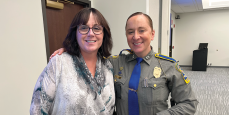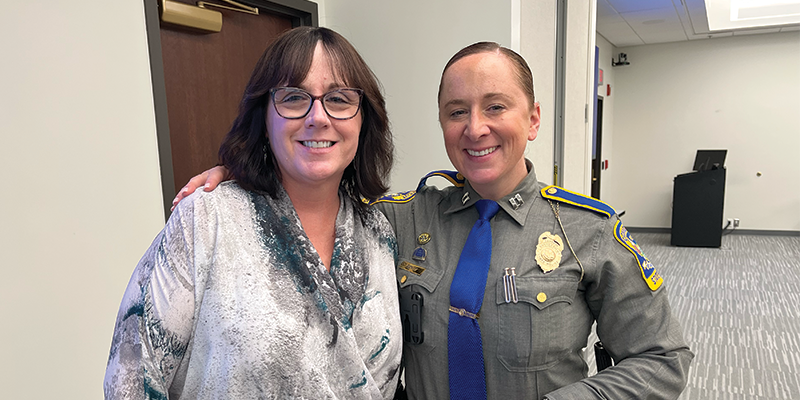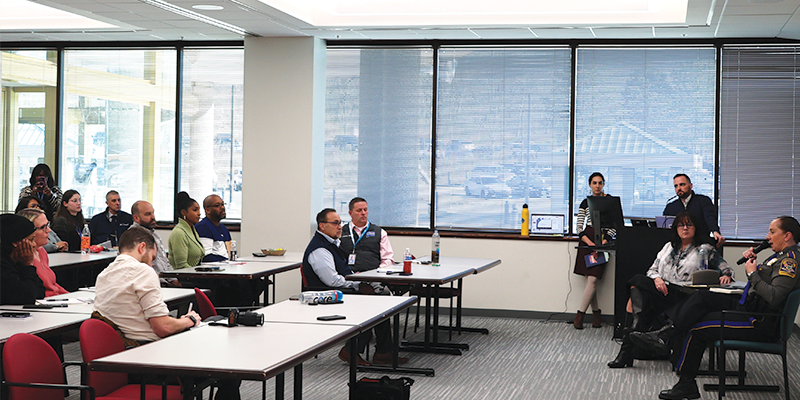Human Trafficking in CT: What to Watch For


Lunch and Learn panelists included experts Tammy Sneed (Connecticut Department of Children and Families) and Captain Katherine Coney (Connecticut State Police).
January is National Human Trafficking Prevention Month, and in recognition, the Connecticut Department of Transportation (CTDOT) hosted CTtransit and other transit organizations for a “Lunch and Learn” discussion about how we can all help prevent this global crisis. The panel was led by experts in the field: Captain Katherine Coney, Connecticut State Police (CSP); Louie Greek, Truckers Against Trafficking (TAT); and Tammy Sneed, Connecticut Department of Children and Families, provided valuable insights and strategies, empowering us all to take action.
“Anyone who works in the transportation space, whether they are in transit, on the rail side, aviation, or in maritime — they are often the eyes and the ears on the ground in being able to stop human trafficking,” said Garrett T. Eucalitto, Commissioner of the CTDOT. “The more we learn about this issue and begin to recognize the signs of human trafficking, the more we can alert law enforcement when we see something wrong.”
CTtransit's operations cover over 25 million local miles annually, including four million miles on the CTfastrak alone. With over 20 million customers boarding buses annually, our professional operators play a vital role in the community, providing opportunities and making a difference in the lives of our customers. “We want people to be good witnesses,” said Captain Katherine Coney, Connecticut State Police (CSP). “If the operator sees something (out of the ordinary with a regular customer), or if they’re unsure – we ask that they call 911.”

Captain Katherine Coney (CSP) shares her expertise on human trafficking prevention.
The "see something, say something" mentality is not just a slogan; it's a commitment. It's a commitment to our communities, to our safety, and to the fight against human trafficking. The CSP cannot start an investigation or build a case unless they know where to look. As a 'Good witness ', you play a vital role in this. You collect detailed information like license plate numbers or visual markers about a suspicious vehicle (bumper stickers, make, and model). You also gather detailed information on suspected traffickers, such as height, hair color, description, etc. Your responsibility is not to interfere, but to give authorities an accurate account of what you saw.
It's easy to look at a small state like Connecticut and think, "Human trafficking couldn't possibly affect us. That only happens in other places."
However, the dangers of human trafficking are very real in the Nutmeg state. In 2024, the Department of Children and Families received over 300 reports of human trafficking.
After the pandemic, when our behaviors shifted increasingly online, these numbers have only risen. NBC Connecticut reports that adult sex trafficking cases in our state are likely underreported.
“A lot of this (criminal activity is happening) online, but oftentimes our youth or vulnerable populations are using our transportation systems and networks to get from place to place,” said Louie Greek (TAT). “These are opportunities for our frontline workers in transportation to identify the potential for human trafficking. By providing training, resources, and information to those critical workers, we can help them identify this problem as it relates to the transportation industry.”
What are common “red flags” to watch for when on the road? Tammy Sneed, Connecticut Department of Children and Families, outlined examples of what to watch for:
Human Trafficking Red Flags include but are not limited to:
- Appearance
- Inadequately or inappropriately dressed for their present situation
- Poor hygiene and/or malnourishment
- Signs of mistreatment - can be sublet (i.e., bald patches)
- Interactions
- Scripted Communication
- Inconsistencies in stories
- Over presence and controlling companion
- Material Flags
- Unexplained gifts or items of value
- Hotel business cards, escort service business cards, hotel key cards
- Number of condoms, sex paraphernalia, excess amounts of cash, or multiple cell phones
By equipping frontline transportation professionals with the proper tools to recognize and report suspicious activity, we are reinforcing their responsibility in the fight against human trafficking. Their commitment to action and training can make a meaningful difference and protect vulnerable populations.
